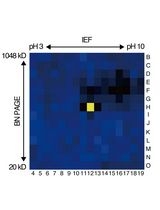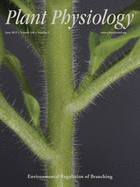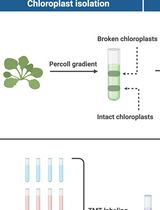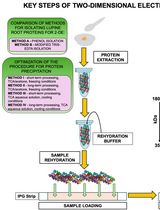- EN - English
- CN - 中文
Cycloheximide Assays to Measure Protein Degradation in vivo in Plants
体内放线菌酮实验测定植物中的蛋白质降解
发布: 2016年09月05日第6卷第17期 DOI: 10.21769/BioProtoc.1919 浏览次数: 19724
评审: Tie LiuYuko KuritaAnonymous reviewer(s)

相关实验方案

基于活性蛋白质组学和二维聚丙烯酰胺凝胶电泳(2D-PAGE)鉴定拟南芥细胞间隙液中的靶蛋白酶
Sayaka Matsui and Yoshikatsu Matsubayashi
2025年03月05日 1094 阅读
Abstract
The half-life of a protein is a characteristic property, and can be modulated by post-translational modifications, changes in subcellular localization, and/or interaction with other proteins or ligands. As one determinant of its steady-state level, a protein’s degradation represents an important distinguishing attribute relevant to its biological function. Because protein longevity cannot be elucidated from bioinformatics analyses, it must be determined empirically. Here we describe two approaches for in vivo half-life determination in plants: 1. pooled-seedling degradation assays monitoring either tagged versions of the protein (luciferase fusions or other epitope tags) or following the endogenous protein; 2. single-seedling degradation assays using luciferase fusion proteins. The advantages of these approaches are their simplicity and low cost.
Keywords: Protein degradation (蛋白质的降解)Background
Materials and Reagents
- 60 x 15 mm sterile Petri dishes (Corning, Falcon®, catalog number: 353002 )
- Microfuge tubes
- Pipet tips
- White polystyrene flat-bottom 96-well plates (Thermo Fisher Scientific, Fisher Scientific, catalog number: 12-566-619 )
- PVDF (polyvinylidene fluoride) Western protein blotting membrane (Sigma-Aldrich, Amersham HybondTM, catalog number: GE10600023 )
- Clear adhesive plate film (USA-Scientific, catalog number: 2921-7810 )
- X-ray film (Thermo Fisher Scientific, Thermo ScientificTM, catalog number: 34091 )
- Plant lines expressing protein of interest, either from transgene or from endogenous locus
- Cycloheximide (CHX) (Sigma-Aldrich, catalog number: C1988 )
- Primary antibody [example, anti-HA-HRP (3F10) (Sigma-Aldrich, Roche, catalog number: 12158167001 )]
- Secondary antibody (horseradish peroxidase-linked) (Bio-Rad Laboratories, catalog number: 1662408EDU )
- Tween-20 (Sigma-Aldrich, catalog number: P9416 )
- Bleach (sodium hypochlorite) (VWR International, Chlorox®, catalog number: 89501-620 ) or from a grocery or drugstore, such as Chlorox bleach
- Murashige and Skoog basal salts with micronutrients (Sigma-Aldrich, catalog number: M5524 )
- Sucrose
- MES [2-(N-morpholino)ethanesulfonic acid] free acid (Merck Millipore, Calbiochem®, catalog number: 475893 )
- Nicotinic acid (Sigma-Aldrich, catalog number: N4126 )
- Thiamine-HCl (Sigma-Aldrich, catalog number: T4625 )
- Pyroxidine-HCl (Sigma-Aldrich, catalog number: P9755 )
- Myo-inositol (Sigma-Aldrich, catalog number: I1525 )
- Potassium hydroxide (KOH) (Thermo Fisher Scientific, Fisher Scientific, catalog number: P250 )
- Bacto agar (BD, Difco, catalog number: 214010 )
- Parafilm (Thermo Fisher Scientific, Fisher Scientific, catalog number: 13-374-10 )
- Liquid nitrogen
- Potassium phosphate monobasic (KH2PO4) (Sigma-Aldrich, catalog number: P9791 )
- Potassium phosphate dibasic (K2HPO4) (Sigma-Aldrich, catalog number: P3786 )
- Ethylenediaminetetraacetic acid (EDTA), disodium dehydrate (Thermo Fisher Scientific, catalog number: S311 )
- β-mercaptoethanol (Sigma-Aldrich, catalog number: M6250 )
- Phenylmethylsulfonyl fluoride (PMSF) (Sigma-Aldrich, catalog number: P7626 )
- Tricine (Sigma-Aldrich, catalog number: T0377 )
- Magnesium chloride hexahydrate (MgCl2) (Thermo Fisher Scientific, Fisher Scientific, catalog number: M33 )
- BSA (bovine serum albumin) for protein standard curve (Sigma-Aldrich, catalog number: A7030 )
- Adenosine 5’-triphosphate disodium salt hydrate (ATP) (Sigma-Aldrich, catalog number: A2383 )
- Tris base (Sigma-Aldrich, catalog number: T1503 )
- Sodium chloride (NaCl) (Sigma-Aldrich, catalog number: S3014 )
- IGEPAL CA-630 [Octylphenoxy poly (ethyleneoxy) ethanol] (Sigma-Aldrich, catalog number: I8896 ), a nonionic, non-denaturing detergent replacement for Nonidet P-40
- MG132 (Benzyloxycarbonyl-L-Leucyl-L-Leucyl-L-Leucinal) (Peptides International, catalog number: IZL-3175-v )
- Complete mini protease inhibitor EDTA-free tablet (Sigma-Aldrich, Roche, catalog number: 4693159001 )
- Protein concentration assay (Bio-Rad Laboratories, catalog number: 5000006 )
- Chemiluminescent western blot development kit (SuperSignal West Pico or Dura Extended duration substrate) (Thermo Fisher Scientific, catalog number: 34077 and 34075 , respectively)
- D-Luciferin potassium salt (Gold Biotechnology, catalog number: LUCK-100 )
- Growth media (GM) (see Recipes)
- Luciferase extraction buffer (see Recipes)
- Luciferase assay buffer (see Recipes)
- Protein extraction buffer for Western blot assays (see Recipes)
Equipment
- Plate reading spectrophotometer for protein determination assay (Thermo Fisher Scientific)
- Refrigerated centrifuge (Eppendorf)
- SDS-PAGE gel apparatus and power supply (Thermo Fisher Scientific)
- Porcelain mortar and pestle for protein extraction (Thermo Fisher Scientific)
- Western transfer apparatus (Thermo Fisher Scientific)
- Plate reading luminometer (Berthold Technologies)
- Flatbed scanner (Hewlett-Packard)
- X-ray film developer, either a set of tanks or trays, or an automatic machine
- Orbital shaker for Western blot incubation (Thermo Fisher Scientific)
Software
- Excel and another statistical package such as GraphPad Prism or Stata
- NIH ImageJ 1.36 (http://rsb.info.nih.gov/ij/)
- ImageQuant 1.0 software (http://www.gelifesciences.com/webapp/wcs/stores/servlet/catalog/en/GELifeSciences-us/products/AlternativeProductStructure_16016/29000605)
Procedure
文章信息
版权信息
© 2016 The Authors; exclusive licensee Bio-protocol LLC.
如何引用
Readers should cite both the Bio-protocol article and the original research article where this protocol was used:
- Gilkerson, J., Tam, R., Zhang, A., Dreher, K. and Callis, J. (2016). Cycloheximide Assays to Measure Protein Degradation in vivo in Plants. Bio-protocol 6(17): e1919. DOI: 10.21769/BioProtoc.1919.
- Gilkerson, J., Kelley, D. R., Tam, R., Estelle, M. and Callis, J. (2015). Lysine residues are not required for proteasome-mediated proteolysis of the auxin/indole acidic acid protein IAA1. Plant Physiology 168(2): 708-720.
分类
植物科学 > 植物生物化学 > 蛋白质
生物化学 > 蛋白质 > 降解
您对这篇实验方法有问题吗?
在此处发布您的问题,我们将邀请本文作者来回答。同时,我们会将您的问题发布到Bio-protocol Exchange,以便寻求社区成员的帮助。
提问指南
+ 问题描述
写下详细的问题描述,包括所有有助于他人回答您问题的信息(例如实验过程、条件和相关图像等)。
Share
Bluesky
X
Copy link











